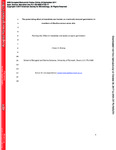The potentiating effect of mandelate and lactate on chemically-induced germination in members of Bacillus cereus sensu lato.
| dc.contributor.author | Bishop, Alistair | |
| dc.date.accessioned | 2017-11-17T17:07:14Z | |
| dc.date.available | 2017-11-17T17:07:14Z | |
| dc.date.issued | 2017-12 | |
| dc.identifier.issn | 0099-2240 | |
| dc.identifier.issn | 1098-5336 | |
| dc.identifier.other | ARTN e01722-17 | |
| dc.identifier.uri | http://hdl.handle.net/10026.1/10202 | |
| dc.description.abstract |
Endospores of the genus Bacillus can be triggered to germinate by a limited number of chemicals. Mandelate had powerful additive effects on the levels and rates of germination produced in non-heat-shocked spores of Bacillus anthracis strain Sterne, Bacillus cereus, and Bacillus thuringiensis when combined with l-alanine and inosine. Mandelate had no germinant effect on its own but was active with these germinants in a dose-dependent manner at concentrations higher than 0.5 mM. The maximum rate and extent of germination were produced in B. anthracis by 100 mM l-alanine with 10 mM inosine; this was equaled by just 25% of these germinants when supplemented with 10 mM mandelate. Half the maximal germination rate was produced by 40% of the optimum germinant concentrations or 15% of them when supplemented with 0.8 mM mandelate. Germination rates in B. thuringiensis were highest around neutrality, but the potentiating effect of mandelate was maintained over a wider pH range than was germination with l-alanine and inosine alone. For all species, lactate also promoted germination in the presence of l-alanine and inosine; this was further increased by mandelate. Ammonium ions also enhanced l-alanine- and inosine-induced germination but only when mandelate was present. In spite of the structural similarities, mandelate did not compete with phenylalanine as a germinant. Mandelate appeared to bind to spores while enhancing germination. There was no effect when mandelate was used in conjunction with nonnutrient germinants. No effect was produced with spores of Bacillus subtilis, Clostridium sporogenes, or C. difficile. IMPORTANCE The number of chemicals that can induce germination in the species related to Bacillus cereus has been defined for many years, and they conform to specific chemical types. Although not a germinant itself, mandelate has a structure that is different from these germination-active compounds, and its addition to this list represents a significant discovery in the fundamental biology of spore germination. This novel activity may also have important applied relevance given the impact of spores of B. cereus in foodborne disease and B. anthracis as a threat agent. The destruction of spores of B. anthracis, for example, particularly over large outdoor areas, poses significant scientific and logistical problems. The addition of mandelate and lactate to the established mixtures of l-alanine and inosine would decrease the amount of the established germinants required and increase the speed and level of germination achieved. The large-scale application of “germinate to decontaminate” strategy may thus become more practicable. | |
| dc.format.extent | AEM.01722-17-AEM.01722-17 | |
| dc.format.medium | Electronic-Print | |
| dc.language | en | |
| dc.language.iso | en | |
| dc.publisher | American Society for Microbiology | |
| dc.subject | Bacillus anthracis | |
| dc.subject | Bacillus cereus | |
| dc.subject | lactate | |
| dc.subject | mandelate | |
| dc.subject | spore germination | |
| dc.title | The potentiating effect of mandelate and lactate on chemically-induced germination in members of Bacillus cereus sensu lato. | |
| dc.type | journal-article | |
| dc.type | Journal Article | |
| plymouth.author-url | https://www.webofscience.com/api/gateway?GWVersion=2&SrcApp=PARTNER_APP&SrcAuth=LinksAMR&KeyUT=WOS:000416937000012&DestLinkType=FullRecord&DestApp=ALL_WOS&UsrCustomerID=11bb513d99f797142bcfeffcc58ea008 | |
| plymouth.issue | 24 | |
| plymouth.volume | 83 | |
| plymouth.publication-status | Published online | |
| plymouth.journal | Applied and Environmental Microbiology | |
| dc.identifier.doi | 10.1128/AEM.01722-17 | |
| plymouth.organisational-group | /Plymouth | |
| plymouth.organisational-group | /Plymouth/Faculty of Science and Engineering | |
| plymouth.organisational-group | /Plymouth/REF 2021 Researchers by UoA | |
| plymouth.organisational-group | /Plymouth/REF 2021 Researchers by UoA/UoA06 Agriculture, Veterinary and Food Science | |
| dc.publisher.place | United States | |
| dcterms.dateAccepted | 2017-09-24 | |
| dc.identifier.eissn | 1098-5336 | |
| dc.rights.embargoperiod | Not known | |
| rioxxterms.versionofrecord | 10.1128/AEM.01722-17 | |
| rioxxterms.licenseref.uri | http://www.rioxx.net/licenses/all-rights-reserved | |
| rioxxterms.licenseref.startdate | 2017-12 | |
| rioxxterms.type | Journal Article/Review |


